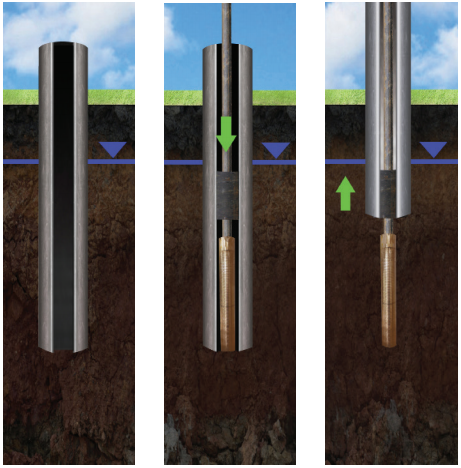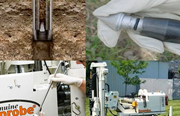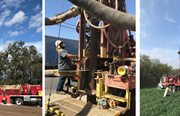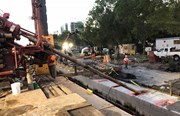Sampling 102: 4 Ways to Collect Deep Groundwater Samples During Drilling
By: Greg ZekoffIf you’re new to environmental services and need to gather data on your site’s subsurface conditions, selecting a deep groundwater sampling method for your project can be overwhelming. To choose the best technique and achieve the results you need, you must consider various factors: overall depth, geology, budget, suspected contaminant, borehole size, quantity of sample required, and drilling method.
Before starting your groundwater sampling project, it's crucial to understand the type of aquifer, characteristics of the geologic formation, and the contaminants of concern you expect to find.
In our on-demand webinar, Sampling 101: Methods of Collecting Environmental Samples During Drilling, industry veterans discuss different environmental sampling methods, their suitable lithologies, and real-life examples of their field applications.
We will explore four deep groundwater sampling methods regularly used with casing advanced drilling systems (like hollow stem auger, sonic, and air rotary casing hammer). While direct push technology is excellent for shallow applications, we'll focus on deeper applications here.
1. Temporary Well Installation
Overview
Temporary well installation is the simplest groundwater sampling method. It involves using a cased hole to run a small diameter casing with a short, perforated section at the bottom. Adding a filter sand and pulling back the outer casing creates a well ready for sampling.
Pros and Cons
-
Advantages: Straightforward and effective for temporary sampling.
-
Drawbacks: More time-consuming and expensive compared to other methods, with additional costs for temporary well materials and, if contamination is present, development/purge water disposal.
2. Isoflow® Discrete Groundwater Sampler
Overview
The ISOFLOW tool obtains high-quality, discrete groundwater samples during drilling. It consists of a small stainless steel screen below a packer assembly. When the outer casing is pulled back, the packer assembly is lowered into the drill casing to the bottom of the hole, sealing the tool and ensuring only groundwater flows through the screen.
Applications
-
Ideal for sites needing high-quality samples and large sample volumes.
-
Useful for low flow pump testing and gauging aquifer yield.
Pros and Cons
-
Advantages: Produces high-quality samples, less expensive than temporary wells, and can be used for pump tests.
-
Drawbacks: Requires purge water disposal and potential sample turbidity.
The ISOFLOW tool consists of a small section of stainless steel screen that sits below a packer assembly. The outer casing is pulled back to expose the screen, the packer assembly is lowered into the drill casing to the bottom of the hole. The packer stays in the casing to seal the tool and make sure that only the groundwater can flow through the screen.
3. Push Ahead Groundwater Sampler
Overview
Push ahead samplers, sometimes referred to as “Hydropunch” tools, are driven ahead of the drilling operation to collect discrete samples without disturbing the drilling area. After being driven a short distance, the device is pulled back to expose a screen for sample collection.
Applications
-
Suitable for minimizing cross-contamination and effective in homogeneous formations like sand and gravel zones.
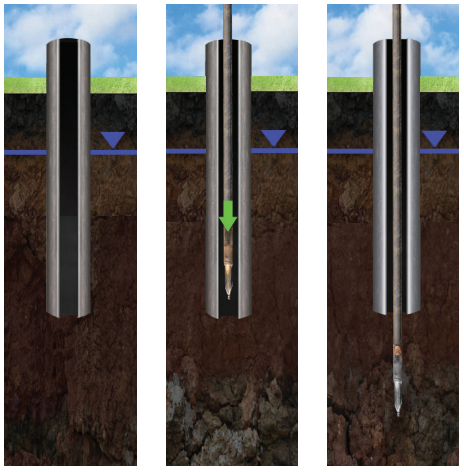
The push ahead sampler tool is driven ahead of the drilling operation, where drilling disturbance has not occurred yet, minimizing the potential for cross contamination when collecting discrete groundwater samples.
Pros and Cons
-
Advantages: Simple, efficient, and cost-effective; minimizes cross-contamination.
-
Drawbacks: Potential turbidity and ineffective in dense, non-conductive formations.
Push ahead groundwater sampling is simple, efficient and cost-effective. This approach is effective when keeping the cost of collecting discrete groundwater samples low is a priority and when turbidity of the samples is not a concern.
When considering this methodology there needs to be a more complete understanding of the subsurface formation and aquifer hydraulics. Traditionally, this groundwater screening option is exercised when the formation is more homogeneous such as a prolific sand and gravel zone or a well-defined higher conductive aquifer. Otherwise, a sample point can be pushed into a zone void of groundwater such as dense clay resulting in a sample void of groundwater.
4. SimulProbe® Soil and Groundwater Sample Collection
Overview
The SIMULPROBE collects both soil and groundwater or soil gas samples simultaneously. It uses a sheath around the driven end of the sampler, perforated at the bottom of the borehole. Groundwater is delivered to a vessel in the tool via small diameter tubes.
Applications
-
Ideal for sites requiring multiple sample types from the same borehole.
Pros and Cons
-
Advantages: Collects multiple sample types, reducing overall costs.
-
Drawbacks: More expensive and time-consuming to set up compared to push ahead samplers.
These four deep groundwater sampling methods are some of the most common, but there are other options. To learn more about groundwater and environmental sampling, watch my on-demand webinar, Sampling 101: Methods of Collecting Environmental Samples.
Drilling Resources & Locations
- National Offices Locations
- Environmental Drilling & Sampling Services
- Drilling Services and Technologies
- Rotary Core Drilling
ABOUT THE AUTHOR

Greg Zekoff
Environmental and Geotechnical Drilling Expert, Retired
Greg Zekoff is a retired registered professional engineer. He served the environmental and geotechnical drilling industry for 35 years. While at Cascade Environmental, Greg worked closely with environmental consultants and engineers solving some of the toughest challenges related to infrastructure drilling, sampling, well installation, and well maintenance. He understands the ins and outs of the major drilling technologies, including auger, sonic, DPT, air and mud rotary. His work with sampling and well construction covers most techniques and drilling methods.
